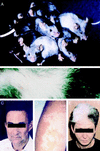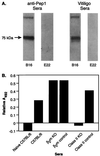Vaccination with a recombinant vaccinia virus encoding a "self" antigen induces autoimmune vitiligo and tumor cell destruction in mice: requirement for CD4(+) T lymphocytes
- PMID: 10077623
- PMCID: PMC15881
- DOI: 10.1073/pnas.96.6.2982
Vaccination with a recombinant vaccinia virus encoding a "self" antigen induces autoimmune vitiligo and tumor cell destruction in mice: requirement for CD4(+) T lymphocytes
Abstract
Many human and mouse tumor antigens are normal, nonmutated tissue differentiation antigens. Consequently, immunization with these "self" antigens could induce autoimmunity. When we tried to induce immune responses to five mouse melanocyte differentiation antigens, gp100, MART-1, tyrosinase, and tyrosinase-related proteins (TRP) 1 and TRP-2, we observed striking depigmentation and melanocyte destruction only in the skin of mice inoculated with a vaccinia virus encoding mouse TRP-1. These mice rejected a lethal challenge of B16 melanoma, indicating the immune response against TRP-1 could destroy both normal and malignant melanocytes. Cytotoxic T lymphocytes specific for TRP-1 could not be detected in depigmented mice, but high titers of IgG anti-TRP-1 antibodies were present. Experiments with knockout mice revealed an absolute dependence on major histocompatibility complex class II, but not major histocompatibility complex class I, for the induction of both vitiligo and tumor protection. Together, these results suggest that the deliberate induction of self-reactivity using a recombinant viral vector can lead to tumor destruction, and that in this model, CD4(+) T lymphocytes are an integral part of this process. Vaccine strategies targeting tissue differentiation antigens may be valuable in cancers arising from nonessential cells and organs such as melanocytes, prostate, testis, breast, and ovary.
Figures





References
MeSH terms
Substances
Grants and funding
LinkOut - more resources
Full Text Sources
Other Literature Sources
Medical
Molecular Biology Databases
Research Materials

